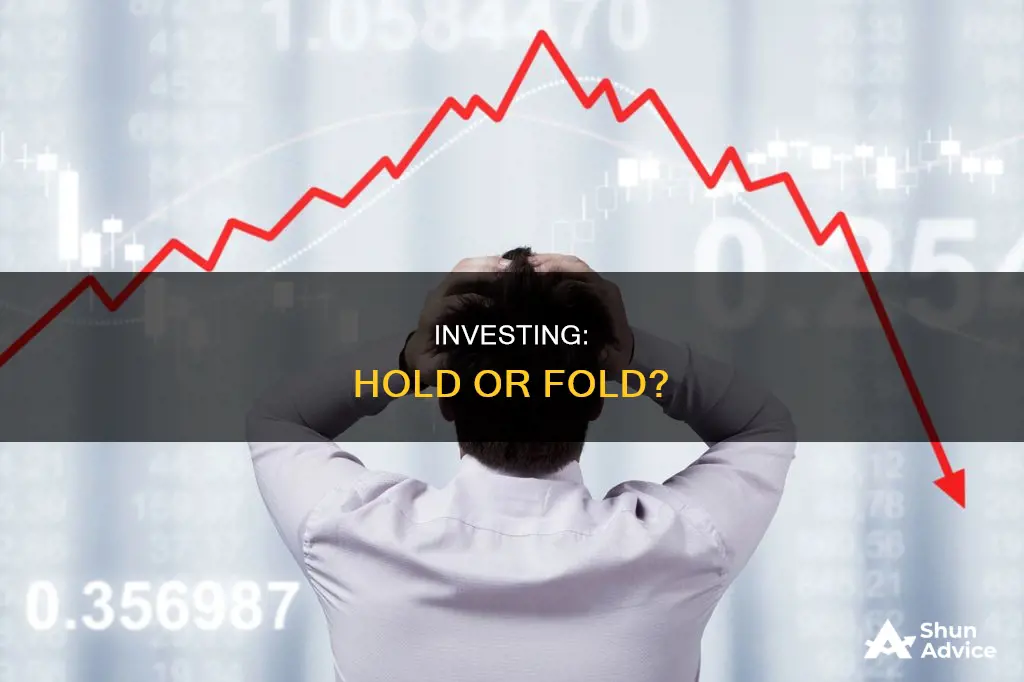
Should you stop investing right now? Well, it depends. If you have some savings to invest, feel ready to buy stocks, and don't need the money for at least five years, then yes, jump in. Even when the market has lows, if you're invested for the long term, you'll have time to recover losses. However, if you don't have an emergency fund, you may want to focus on that goal before investing your spare cash.
| Characteristics | Values |
|---|---|
| Should I stop investing? | It depends on your unique situation. |
| When is it smart to keep investing? | In general, it's a good idea to continue investing regardless of what the market is doing. |
| When is it better to avoid investing? | If you don't have an emergency fund or you expect to need your extra cash in the near future. |
| What is dollar-cost averaging? | A technique where you invest a specific dollar amount at regular intervals rather than trying to time the market. |
| What is a bear market? | When the market falls 20% or more from its most recent high. |
What You'll Learn

Don't panic
It's normal to feel anxious when the stock market drops, but it's important to keep a cool head and avoid making impulsive decisions. Here are some reasons why you shouldn't panic:
Understand the Cyclical Nature of the Market:
The stock market moves in cycles, with ups and downs being a regular occurrence. It's essential to remember that downturns are temporary and part of the broader market cycle. Historically, the market has always recovered from crashes and continued its upward trajectory.
Long-Term Focus:
Adopting a long-term perspective is crucial. While short-term volatility can be unnerving, the stock market has consistently proven to outperform other asset classes over the long term. Focus on the bigger picture and remember that the market will likely recover and reach new highs.
Buying Opportunities:
Market downturns present strategic buying opportunities. When the market is in a slump, stock prices are lower, allowing you to purchase shares of valuable companies at a discount. This can result in significant savings compared to investing only when the market is thriving.
Power of Compounding:
Investing is a tool to build wealth over time through the magic of compounding returns. Pulling out of the market during a downturn means missing out on the potential for your investments to grow and compound over the long term.
Know Your Risk Tolerance:
Understanding your risk tolerance is essential for making informed investment decisions. Assess your comfort level with market volatility and choose investments that align with your risk profile. This will help you avoid panicking during market downturns and make more rational choices.
Diversification is Key:
Diversifying your portfolio across various asset classes, sectors, and industries can help mitigate risk. By spreading your investments, you reduce the impact of any single market crash and protect your overall portfolio.
Have a Strategy:
Instead of panicking, formulate a plan to navigate market downturns. This could include understanding your risk tolerance, diversifying your portfolio, and adopting a long-term perspective. A well-thought-out strategy will help you stay calm and make rational decisions.
In summary, while it's understandable to feel anxious during market downturns, it's crucial to avoid panic selling or making impulsive decisions. Remember that the stock market is cyclical, and focus on adopting a long-term perspective. Take advantage of buying opportunities, understand your risk tolerance, diversify your portfolio, and stick to your investment strategy.
Congress' Stock Secrets
You may want to see also

Invest in quality companies
Investing in quality companies is a strategy that focuses on identifying and investing in businesses with specific characteristics that indicate strong performance and long-term growth potential. This approach, popularised by Benjamin Graham, the father of value investing, involves seeking out companies that possess certain qualities, often referred to as "quality investments" or "quality stocks".
Quality investing is based on a set of fundamental criteria, both soft and hard. Soft criteria include factors like management credibility and competence, while hard criteria include tangible metrics such as balance sheet stability, profitability, and efficient operations.
- Good Management: Quality companies tend to have stable upper management with low turnover rates. The ability to capitalise on opportunities and effective decision-making are hallmarks of strong leadership.
- Strong Balance Sheet: A quality company typically has a robust balance sheet, indicating its ability to withstand adverse economic conditions or unexpected challenges. Look for companies with low debt, efficient management of liabilities, and positive financial momentum.
- Enterprise Life Cycle: Consider the company's position in its enterprise life cycle. Is it innovative and adaptive? Does it reinvest in technology and focus on efficiency and product enhancement?
- Competitive Advantage (Economic Moat) Warren Buffett popularised the term "economic moat," referring to a company's competitive advantages that act as barriers to potential competitors. These advantages can include unique products, strong brand recognition, or proprietary technology.
- Dividend-Paying Stock: A history of consistent and growing dividend payments is a sign of a quality company. Dividend growth compounding can be a powerful financial concept and a significant advantage for investors.
- Stable Earnings: Quality companies generally exhibit stable and predictable earnings, reducing the risk of forecasting errors and disappointing investors.
- Operating Efficiency: Efficient operations are a hallmark of quality companies. Measure operating efficiency using metrics such as Return on Assets (Net Income/Assets) and compare it to industry peers to identify well-run businesses.
- Market Positioning: Quality companies often possess a strong market position, operating in industries with growth potential and benefiting from global trends.
- Business Model: The BCG matrix classifies business models as either "stars" (growing, large capex) or "cash cows" (established, ample cash flows, attractive dividends). Quality companies typically fall into one of these categories.
- Attractive Valuation: Quality investing also considers valuation, seeking companies with high discounted cash flows, low P/E ratios, and low P/B ratios.
By focusing on these characteristics, investors can identify quality companies that have the potential to deliver strong and consistent long-term returns. It's important to remember that investing is a marathon, not a sprint, and quality investing requires a disciplined and patient approach.
Investing: Personal Definitions of Risk and Reward
You may want to see also

Understand your risk tolerance
Understanding your risk tolerance is a key part of investing. Risk tolerance is the degree of risk that an investor is willing to accept, given the volatility in the value of an investment. It often determines the type and amount of investments that an individual chooses.
There are three main types of risk tolerance: aggressive, moderate, and conservative. An aggressive investor has a higher risk tolerance and is willing to risk more money for the possibility of better, yet unknown, returns. Their investments emphasize capital appreciation rather than income or preserving their principal investment. This investor's asset allocation commonly includes stocks and little or no allocation to bonds or cash.
A moderate investor wants to grow their money without losing too much. Their goal is to weigh opportunities and risks, and their approach is sometimes described as a “balanced” strategy. They commonly develop a portfolio that includes a mixture of stocks and bonds, perhaps as a 50/50 or 60/40 structure.
A conservative investor has a lower risk tolerance and is willing to accept little to no volatility in their investment portfolios. They seek investments with guaranteed returns. Retirees or those close to retirement age are often included in this category as they may be unwilling to risk a loss to their principal investment and have a short-term investment strategy. A conservative investor targets vehicles that are guaranteed and highly liquid. Risk-averse individuals commonly opt for bank certificates of deposit (CDs), money markets, or U.S. Treasuries for income and preservation of capital.
Your risk tolerance is influenced by several factors, including age, investment goals, income, future earning capacity, and the presence of other assets. For example, younger people are often considered to have a higher risk tolerance because they have a longer time horizon and can afford to take on more risk. However, it's important to consider your individual circumstances when determining your risk tolerance, as people are living longer and can remain aggressive investors for longer. Additionally, investors with a larger portfolio may be more tolerant of risk, as the percentage of loss is much less compared to a smaller portfolio.
It's also important to carefully consider your investment goals when assessing your risk tolerance. For example, if you are saving for retirement, you may want to be more cautious with your investments. On the other hand, if you are using disposable income to attempt to earn extra income, you may be willing to take on more risk.
Online risk tolerance assessments and questionnaires can help you understand your risk tolerance. By answering questions about your age, investment goals, income, and other factors, you can gain insight into your risk tolerance and make more informed investment decisions.
Investing in People: Avoid the Wrong Ones
You may want to see also

Prepare for and limit your losses
When it comes to investing, it's important to remember that losses are inevitable. However, there are strategies you can employ to help you prepare for and limit your losses. Here are some tips to help you navigate the world of investing:
- Fighting the inclination to hang on to losers: It's human nature to be risk-averse when it comes to winning investments and risk-seeking when holding losing investments. This behaviour can hinder your success in the stock market. To counter this, you should train yourself to cut your losses and hold on to your winning investments.
- The larger the loss, the larger the recovery: Keeping your losses small is crucial. The bigger the loss, the bigger the gain needed to recover. Consider losses as an insurance premium to protect your capital.
- Learn from Warren Buffett: Buffett's two rules of investment are: 1) Don't lose money, and 2) Don't forget the first rule. He advises getting out of an investment as soon as it starts losing value.
- Use stop-loss orders: A stop-loss order is a tool that automatically sells a security when it reaches a certain price, limiting your loss. This can be set at a specific dollar amount or a percentage below the current market price. Stop-loss orders can help you stick to your investment strategy and prevent emotional decision-making.
- Trailing stops: This is a type of stop-loss order that follows the stock price as it rises. When the stock price falls, the trailing stop turns into a market order, and the stock is sold, helping you avoid further losses.
- Have an exit strategy: It is important to have an exit strategy in mind before investing. Ask yourself, "When will I exit my position, and why?" Having a plan can help you make more rational decisions when the time comes.
Why Pay for Aaii Membership?
You may want to see also

Focus on the long term
Investing is a long-term game. If you're investing for the long term, you can take advantage of the market's downturns and focus on your financial goals without worrying about short-term market volatility. Here are some tips to keep in mind:
Get Your Finances in Order
Before investing for the long term, it's important to assess your financial situation. Understand how much money you have available to invest and ensure that you have a reasonable debt management plan and a well-funded emergency fund. This will help you avoid the need to withdraw your investments prematurely, which may result in selling at a loss and incurring tax implications.
Know Your Time Horizon
Long-term investing typically refers to a timeframe of five years or more. Understanding your investment goals and time horizon is crucial for determining the appropriate level of risk you should take. For example, if you're investing for a child's college education, you may be able to invest more aggressively if the child is 18 years away from starting college, as your portfolio will have more time to recover from market volatility.
Pick a Strategy and Stick with It
Choose an investment strategy that aligns with your goals and time horizon, and remain committed to it. You can divide your long-term investments into different buckets based on the target dates of your goals. For instance, you can have a more conservative portfolio for goals that are 5-15 years away and a more aggressive portfolio for goals that are more than 30 years away.
Understand Investing Risks
Be aware of the risks associated with different types of investments. Stocks are generally considered riskier than bonds. Within stocks, there are also varying levels of risk. For example, U.S. stocks are often seen as safer than stocks from countries with developing economies due to greater economic and political uncertainties in those regions. Assess your risk tolerance and choose investments that align with your comfort level.
Diversify Your Investments
Diversification is a key aspect of successful long-term investing. Spread your investments across a variety of assets to increase your chances of positive returns over time. Consider investing in a mix of large-cap, mid-cap, and small-cap stocks, as well as growth and value stocks. Mutual funds and exchange-traded funds (ETFs) are excellent tools for achieving diversification, as they provide exposure to a wide range of individual stocks and bonds.
Mind the Costs of Investing
Investing fees and expenses can impact your returns over time. Pay attention to expense ratios, management fees, and trading fees associated with your investments. Seek out low-cost investment options, such as index funds, to minimize fees. Remember that higher fees don't always guarantee better performance.
Review Your Strategy Regularly
While it's important to stick to your investment strategy, it's also crucial to review and adjust your portfolio periodically. Check your allocations to ensure they align with your target allocations. Rebalance your portfolio as needed to maintain your desired level of risk. Additionally, keep an eye on the performance of your holdings and make changes if they deviate from your expectations or goals.
Raisin in the Sun" Investors Reveale
You may want to see also







